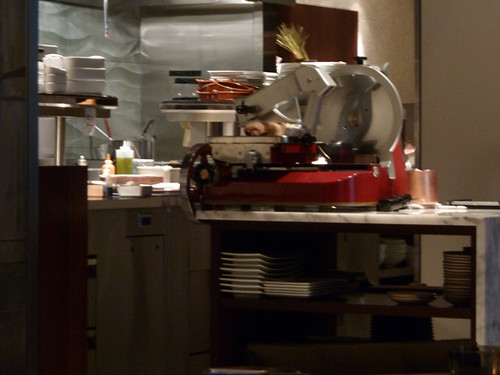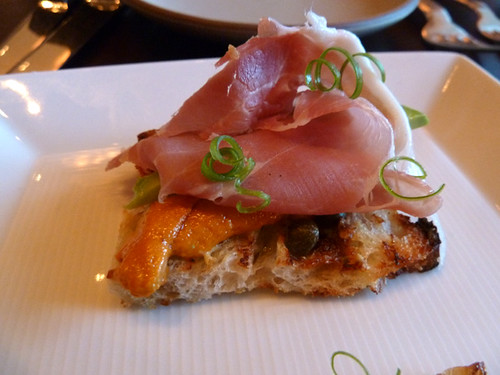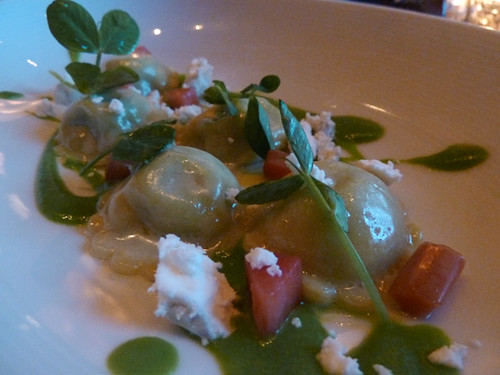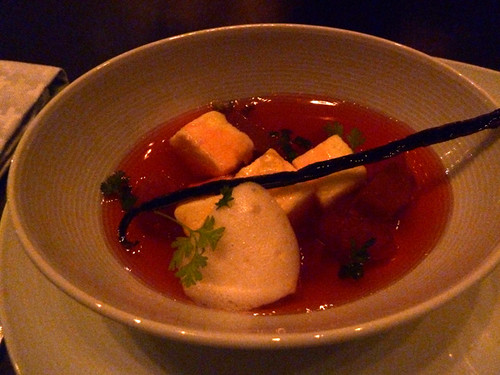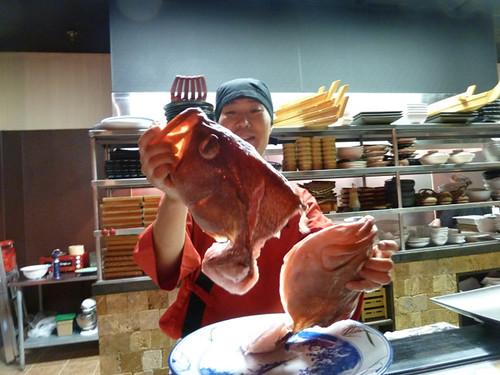
So did we all just agree to pretend that we knew words like “izakaya” and “robata grill” a year ago? Restaurant owners are opening them like mad and food writers are using them like they’ve known them since grade school, but while I certainly knew that there was Japanese food grilled on sticks before last week, the word for it tended to be “yakitori”— as it still is at by far the best and seemingly most authentic of them I’ve been to, Yakitori Totto in New York. But I think in general “yakitori” came to be associated with chicken sticks in mall food courts, so new words were imported for trendier spots. Nonetheless, after eating at three different American versions of this general category of cuisine, I’m not sure I’m not more confused about what the real Japanese version of this is like than I was before. There’s often good food to be had, on sticks and off, but “izakaya” seems to be quickly becoming as non-specific as, say, bistro or trattoria.
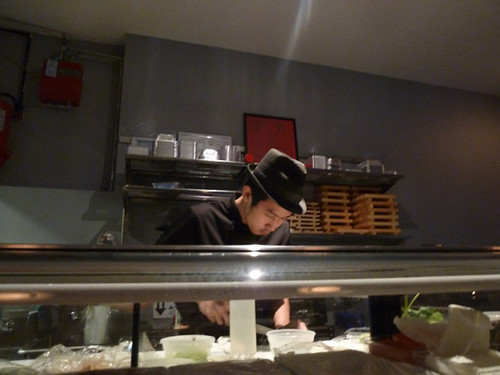
Yuzu Sushi & Robata Grill doesn’t say izakaya but the promise of a robata grill— well, the first time I heard the term I feel I was promised a giant robot cooking my food, but it turns out to mean kind of a campfire cookout using a particular (and expensive) form of oak charcoal called binchotan. Only the high end places in town actually use that (Sushi Samba Rio and the new Roka Akor, apparently), and so far as I can tell, Yuzu is just using a standard restaurant grill. Yuzu’s up-to-the-minute trendiness cred is nonetheless furnished by sushi chefs in hipster hats, obscenity-filled rap blaring over the speakers, and, well, the trendy fruit in the name.
What this turns out to be in reality is a reasonably priced neighborhood sushi joint with some cooked items, and on those terms it wasn’t bad at all. The sushi wasn’t overly dressed up— yes, it had a sliver of lime on top, but at least they weren’t drowning good fish in unneeded flavors or pushing gooed-up maki rolls. A curry puff was like most Japanese curries, sweet and lacking complexity next to Indian curries, but enjoyably comfy.

The grilled items off the robata grill went two for four, I thought. The steak and scallop were simple and just what they should be. A rectangular hunk of pork was too thick and coated in too much sesame-paste sauce, and chicken was a little dry and underexciting. I wish there were more and more unusual offerings, a la Chizakaya, especially since I would have had bigger portions for less of them here. Yuzu isn’t a place to go out of your way to visit, but it’s a little more unusual and interesting than the generic neighborhood sushi place found all over town.
Yuzu Sushi & Robata Grill
1715 West Chicago Avenue
Chicago, IL 60622
(312) 666-4100
When you gaze across the dining room of Tokio Pub you can imagine yourself in any fashionably dark and sleek Asian-hipster locale in the city. Only once your gaze reaches the window and sees parking lot stretching like a Texas ranch beyond does it become obvious you’re in Streets of Woodfield, attached in fact to the branch of Shaw’s in the parking lot (better to be Shaw’s spinoff than Big Bowl’s).
I came here as a guest of the publicist, ostensibly because they were having Maki Month or something like that. For me, maki rolls are guilty until proven innocent, all cute names and sweet flavors obliterating any Asian fish flavor; and I wasn’t encouraged here by the fact that their menu features tacos (I still don’t get that). So I gravitated as much as I could to the grilled items off their, yes, robata grill, the menu says so.
Surprisingly, the maki were admirably restrained, not overdressed, simple and with clean fish flavors. Also surprisingly, a drink with the ghastly-girly name of Blushing Geisha (I asked the bartender to instead call it a Stammering Samurai) was a nicely tart, well-balanced gin cocktail (with prickly pear juice and lime sour). Like the decor, this part of the menu transcended the cartoonish concepting and seemed pretty genuinely cool and good. If you ever have a need for a hip place to get a drink and some snacks in Schaumburg, I can’t imagine there’s a better choice. Or many at all, but still.
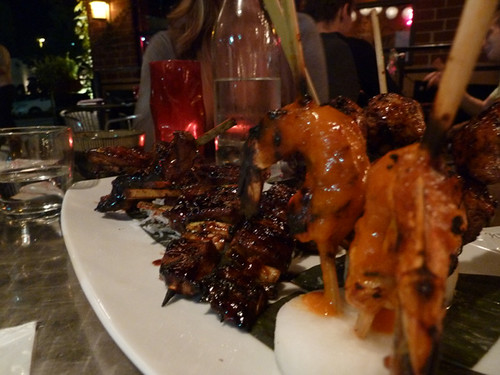
Unfortunately, the robata grill items had been American-suburbanized-supersized-gloppified. All the cuts were too huge to grill well or eat off a stick comfortably; all except the spicy shrimp were coated in a thick honeyish glaze straight out of the orange chicken at Panda Express. There was good meat under there, but it didn’t need to be, the way it was mistreated. The virtues of small, freshly grilled slices of meat are so obvious, I can’t imagine how anyone saw that and thought, what this needs is to be dripping high fructose corn syrup by the quart. Bummer. The meal ended with dessert sushi, which I preferred to think of as a Moto-like joke course, looks like sushi, tastes like Fro-Yo! Anyway, the creme brulee was fine.
I never did find out what the tacos were about. Maybe by the rule of inverse expectations at play here, they’re pretty good.

Tokio Pub
1900 E Higgins Rd
Schaumburg, IL 60173
(847) 278-5181
tokiopub.com/

Izakaya Yume is in what at first glance seems a hardly more prepossessing location for authenticity— a strip mall at Golf and Milwaukee. But in fact this stretch of Niles is a little hidden-in-plain-sight ethnic food-shopping enclave— catecornered is Himalayan Restaurant, the Nepali place David Hammond, Jennifer Olvera and I visited in Hammond’s recent radio exploration of suburbia’s ethnic gems. Korean is dominant in this stretch, with Polish a close second, and Izakaya Yume appears to be a Japanese restaurant run by Koreans. It was less like other izakayas I’ve been to— no food on sticks, at least for grilling rather than making them pretty— and it’s basically all fish-oriented, no beef skewers or chicken fat, but however much it matches an authentic Japanese izakaya or not, it’s an authentic something, and making very simple Asian food very well for prices that are scandalously cheap.
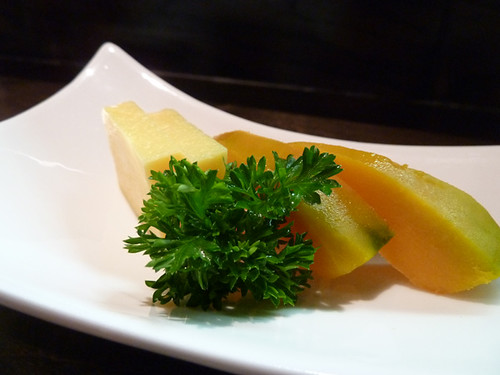
A few free starters aside, we began with a sashimi platter, but urged the chef— formerly of Japonais— to pick us out interesting things and not assume that we wanted the safest choices. He decided to give us about half of his standard sashimi platter for two, and to round it out instead with a small mackerel cut into pieces, showing us a small tray of the gleaming black fish to close the deal.
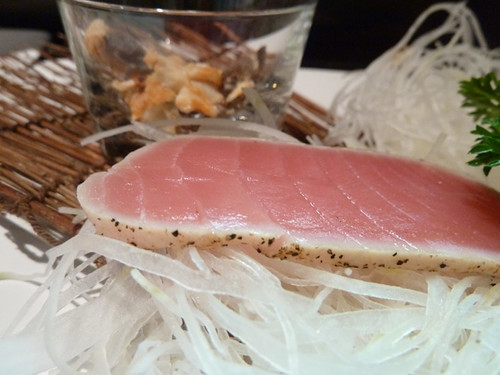
If describing food is hard, describing slices of raw fish is harder yet, so there’s little to say except that it was all of excellent quality, pristine and impeccably fresh, sliced with skillful delicacy. At $21.99 for a good twenty pieces (plus a terrific little octopus salad), it was a steal.
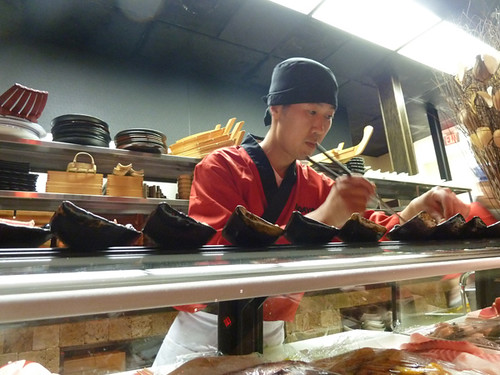
A discordant note came when we saw him preparing oysters for a large party. My dining companion shriveled in horror as the chef washed the liquor out of the oysters in his sink, then replaced it with soy sauce. I could tell he thought this was sacrilege, losing the best part of the oyster down the drain. Ten of them went off to the large party… and then the chef plated two more for us, on the house. My friend tried to smile, kind of like the one Christina Ricci makes when she gets sent to happy-time camp in one of the Addams Family movies.
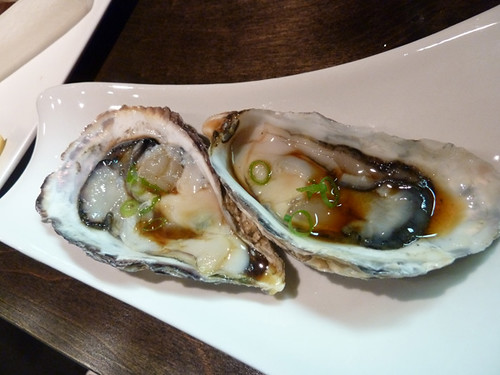
They were all right, but even I, oyster-clueless as I am, don’t get why you’d want to ditch the liquor. Anyway, next up we tried to order a couple of things off the grilled menu, which features about 7 or 8 fish (plus a few more as specials). The chef urged us to only order one. We looked at each other and felt pretty confident we could polish off two filets of fish between us, but for the moment, accepted his advice. I mean, the mackerel we ordered was only $12.99, how big could it be?
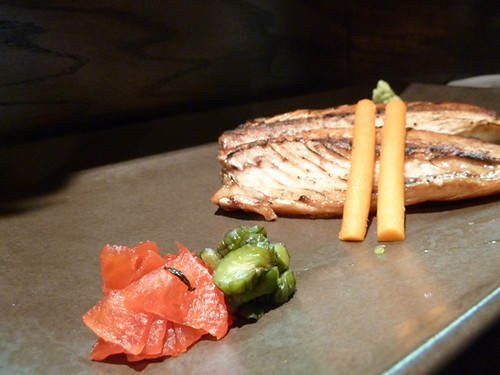
Like the Hungryman’s Special at Red Lobster, that’s how big. It basically was two full filets a foot long from the meatiest part of a good-sized fish. Again, the preparation was simple and perfect, grilled to a crisp but just a nudge past flaky inside, the oil collecting at the bottom for when you wanted especially crispy-greasy bites.
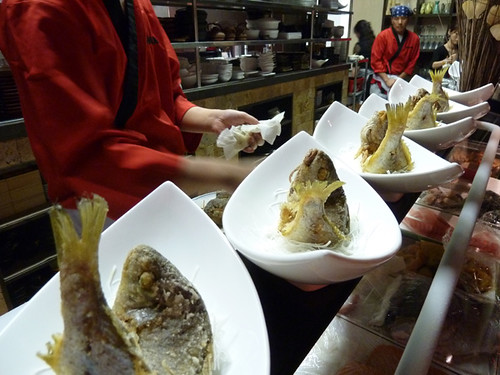
The price in the end was $90, but considering that $40 of that was a bottle of sake, this was an utter bargain for the quality and quantity of the fish and the chefly attention paid to our meal. (It helped that it was a quiet Tuesday night; I have a feeling on a busy Friday night, the painstaking attention paid to each dish would really slow things down.) Roka Akor, in River North, may by all reports be the Japanese restaurant of the year, but for those of us not on an expense account capable of encompassing a $14 truffle shaving add-on to our $144 wagyu steak, it’s far more exciting to find a discovery like this making genuinely first-rate food at delivery pizza prices. The only thing some might find no bargain is the seating; for some reason, the bar seats are down at kindergarten classroom level, making it hard to see what’s going on far, far above you with the chef, and harder to get back up to a standing position once you’re full. I don’t know whether those chairs are authentic to the izakaya experience either, but they’re a price I’m willing to pay for whatever authentic experience this was.
Izakaya Yume
9626 N Milwaukee Ave
Niles, IL 60714
(224) 567-8365


 Posted in
Posted in 


